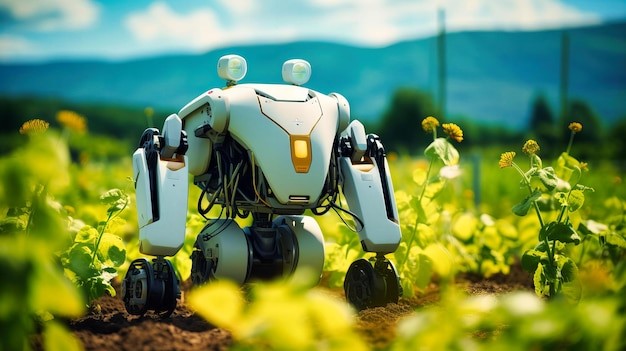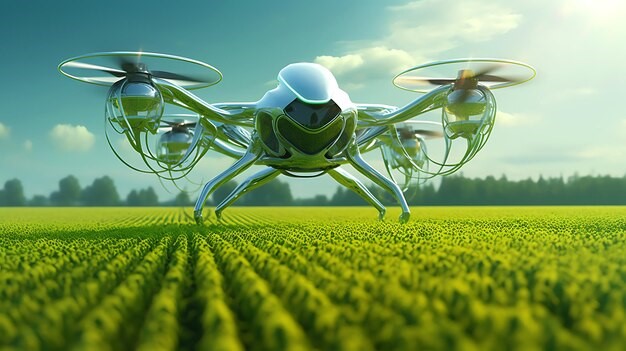Robotics and Automation in Agriculture
Robotics and automation are rapidly transforming the agricultural landscape, addressing labor shortages, increasing efficiency, and enhancing precision in farming practices. [1] The integration of these advanced technologies into agriculture is enabling farmers to perform tasks that were previously labor-intensive and time-consuming with greater accuracy and consistency.

Figure 1.Robotics and Automation in Agriculture
Figure 1 Shows Robotics and Automation in Agriculture. Here’s an in-depth exploration of how robotics and automation are revolutionizing agriculture.
Key Applications of Robotics and Automation in Agriculture
Autonomous Machinery:
- Autonomous Tractors: Equipped with GPS and AI systems, autonomous tractors can plow, seed, and harvest crops with minimal human intervention. These tractors follow precise routes, optimizing field operations and reducing fuel consumption.
- Robotic Harvesters: Robotic harvesters use AI and machine vision to identify and pick ripe fruits and vegetables. These robots can work continuously, ensuring timely and efficient harvesting, and reducing crop waste.
Drones and UAVs (Unmanned Aerial Vehicles):
- Crop Monitoring: Drones equipped with cameras and sensors can survey large fields quickly, capturing high-resolution images and data on crop health, growth stages, and soil conditions. AI analyzes this data to provide actionable insights.
- Precision Spraying: Drones can perform targeted spraying of pesticides, herbicides, and fertilizers. This precision reduces chemical use, minimizes environmental impact, and ensures that only the necessary areas receive treatment.
Weeding Robots:
- Automated Weeders: These robots use machine vision and AI to distinguish between crops and weeds, removing unwanted plants without harming crops. This reduces the need for chemical herbicides and promotes sustainable farming practices.
- Laser Weeding: Some advanced weeding robots use lasers to target and eliminate weeds, offering a non-chemical solution to weed control.
Planting and Seeding Robots:
- Precision Planters: These robots plant seeds at optimal depths and spacing, ensuring uniform growth and maximizing yield. They use AI to adjust planting patterns based on soil conditions and crop requirements.
- Seedling Transplanting: Robots that transplant seedlings can handle delicate plants with precision, reducing transplant shock and improving survival rates.
Livestock Management:
- Automated Milking Systems: Robotic milking systems can milk cows with minimal human intervention, improving efficiency and animal welfare. These systems monitor the health and productivity of each cow.
- Feeding Robots: Automated feeders provide precise amounts of feed based on the nutritional needs of livestock, promoting better growth and reducing waste.
Benefits of Robotics and Automation in Agriculture
- Labor Efficiency: Robots and automated systems can perform repetitive and labor-intensive tasks more efficiently than humans, addressing labor shortages and reducing the physical strain on farm workers.
- Precision and Accuracy: Automation ensures that tasks such as planting, spraying, and harvesting are performed with high precision, improving crop quality and yield while minimizing waste.
- Cost Reduction: Precision agriculture techniques promoted by robotics reduce the use of chemicals and water, promoting more sustainable farming practices and minimizing environmental impact.
- Sustainability:Precision agriculture techniques promoted by robotics reduce the use of chemicals and water, promoting more sustainable farming practices and minimizing environmental impact.
- Data Collection and Analysis: Automated systems collect vast amounts of data on crop and livestock conditions, providing valuable insights for better decision-making and farm management.
Challenges and Future Directions
- High Initial Investment: The cost of acquiring and implementing robotic systems can be high, which may be prohibitive for small-scale farmers. Making these technologies more affordable and accessible is crucial.
- Technical Complexity: Operating and maintaining robotic systems require technical expertise, which may necessitate additional training and support for farmers.
- Integration with Existing Systems: Integrating new robotic technologies with existing farm equipment and practices can be challenging. Ensuring compatibility and seamless operation is essential.
- Reliability and Robustness:Agricultural environments can be harsh, and robotic systems need to be robust and reliable to function effectively under varying conditions.
Robotics and automation are revolutionizing agriculture by enhancing efficiency, precision, and sustainability. As these technologies continue to advance and become more accessible, they will play an increasingly vital role in addressing the challenges of modern farming, ensuring food security, and promoting sustainable agricultural practices. By leveraging robotics and automation, the agricultural sector can achieve significant improvements in productivity, cost-efficiency, and environmental stewardship.
References:
- https://robotnik.eu/robotics-applications-in-agriculture/
Cite this article:
Janani R (2024), AI in Agriculture: Transforming Farming Practices, Anatechmaz,pp.4





